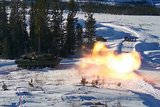US Army Selects Northrop Grumman's 100kW solid-state laser for field tests at its High Energy Laser Systems Test Facility
The solid-state laser system from Northrop Grumman Corporation that produced the most powerful beam ever from a continuous wave, electric laser last year is joining other pioneering speed-of-light weapons demonstrators for field tests at the Army's High Energy Laser System Test Facility (HELSTF), N.M.
In cooperation with the US Army's Space and Missile Defense Command/Army Forces Strategic Command, which operates the test range at White Sands Missile Range in southeastern New Mexico, BAE Systems has contracted with Northrop Grumman to relocate the Joint High Power Solid State Laser (JHPSSL) Phase 3 system from the company's laser factory in Redondo Beach, Calif., to HELSTF. Field testing is expected to begin this year.
This laser will be integrated with the beam control and command and control systems from another Northrop Grumman-built system, the Tactical High Energy Laser (THEL), to provide the Army with the world's first high-power, Solid State Laser Testbed Experiment (SSLTE).
"Northrop Grumman will have a lead role in integrating and operating the Army's solid-state laser test bed," said Steve Hixson, vice president of Advanced Concepts – Space and Directed Energy Systems for Northrop Grumman's Aerospace Systems sector. "We bring substantial expertise to this project from our many years of experience building and demonstrating tactically-relevant laser systems."
The SSLTE will be used to evaluate the capability of a 100kW-class solid-state laser to accomplish a variety of missions. Those results will be the basis for directing future development of solid-state lasers as a weapon system. "Solid-state lasers have achieved militarily useful power levels and packaging densities," said Dan Wildt, vice president of Directed Energy Systems.
"We have been demonstrating laser performance at HELSTF and other test sites for many years, unequivocally proving their lethality against a wide variety of potential threats." These include missiles of various sizes and speeds, helicopters, drones, rockets, artillery, mortar rounds and submunitions.
Both the relocation of the JHPSSL Phase 3 device and the THEL facility refurbishment are being carried out under an Army contract with BAE Systems, which has overall responsibility for the SSLTE systems engineering and test planning. BAE Systems is also developing a modular and transportable enclosure to house the JHPSSL device and its control room at the site.
Under the JHPSSL program, Northrop Grumman became the first company to reach the 100kW power level threshold for a solid-state laser. The achievement also included turn-on time of less than one second and continuous operating time of greater than five minutes, with very good efficiency and beam quality.
The JHPSSL program is funded by the Office of the Assistant Secretary of the Army for Acquisition, Logistics, and Technology; Office of the Secretary of Defense – High Energy Laser Joint Technology Office, Albuquerque, N.M.; Air Force Research Laboratory, Kirtland Air Force Base, N.M.; and the Office of Naval Research, Arlington, Va. Responsibility for program execution is assigned to USASMDC/ARSTRAT in Huntsville, Ala.
Northrop Grumman designed and built the Mid-Infrared Advanced Chemical Laser (MIRACL) for the US Navy, which was a megawatt-class, continuous wave chemical laser. The company also developed the first standalone, fully integrated laser weapon system demonstrator, the THEL test bed, which was a joint effort by the Army and Israel's Ministry of Defence to engage short-range Katyusha l rockets.
Both MIRACL and THEL were high-power lasers based at HELSTF within the grounds of White Sands Missile Range. At HELSTF, the Army tests high-energy laser technologies and weapon systems for propagation, lethality, survivability and dynamic engagements. HELSTF has access to the 3,200 square miles of restricted land area and 7,000 square miles of restricted airspace at White Sands to conduct such tests.
Source: Northrop Grumman
More from Digital Battlespace
-
![Babcock nears first customer for Nomad AI translation tool]()
Babcock nears first customer for Nomad AI translation tool
Nomad can provide militaries with real-time intelligence, saving critical time on the battlefield.
-
![AUSA 2025: Israel’s Asio Technologies to supply hundreds of improved Taurus tactical systems]()
AUSA 2025: Israel’s Asio Technologies to supply hundreds of improved Taurus tactical systems
Taurus operates alongside the Israel Defense Forces’ Orion system which supports mission management across tens of thousands of manoeuvring forces, from squad leaders to battalion commanders.
-
![AUSA 2025: Kopin pushes micro-LED plans as China moves faster]()
AUSA 2025: Kopin pushes micro-LED plans as China moves faster
The plan for the new displays follows fresh investment in Kopin’s European facilities by Theon and an order for head-up displays in fielded aircraft, with funding from the US Department of Defense.
-
![AUSA 2025: Persistent Systems to complete its largest order by year’s end]()
AUSA 2025: Persistent Systems to complete its largest order by year’s end
Persistent Systems received its largest ever single order for its MPU5 devices and other systems earlier this month and has already delivered the 50 units to the US Army’s 4th Infantry Division.
-
![Aselsan brings in dozens of companies and systems under the Steel Dome umbrella]()
Aselsan brings in dozens of companies and systems under the Steel Dome umbrella
Turkey has joined the family of countries attempting to establish a multilayered air defence system with government approval in August 2024 for the effort landed by Aselsan. Dubbed Steel Dome, the programme joins Israel’s Iron Dome, the US Golden Dome, India’s Mission Sudarshan Chakra and South Korea’s low-altitude missile defence system.
-
![DSEI 2025: MARSS unveils new agnostic multidomain C4 system]()
DSEI 2025: MARSS unveils new agnostic multidomain C4 system
MARSS’ NiDAR system has been deployed using sensors from static platforms to provide detection and protection for static sights, such as critical infrastructure, ports and military bases.




























